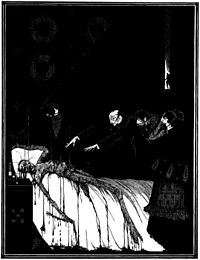
"The Black Cat" is a short story by the American writer Edgar Allan Poe. It was first published in the August 19, 1843, edition of The Saturday Evening Post. In the story, an unnamed narrator has a strong affection for pets until he perversely turns to abusing them. His favorite, a pet black cat, bites him one night and the narrator punishes it by cutting its eye out and then hanging it from a tree. The home burns down but one remaining wall shows a burned outline of a cat hanging from a noose. He soon finds another black cat, similar to the first except for a white mark on its chest, but he develops a hatred for it as well. He attempts to kill the cat with an axe but his wife stops him; instead, the narrator murders his wife. He conceals the body behind a brick wall in his basement. The police soon come and, after the narrator's tapping on the wall is met with a shrieking sound, they find not only the wife's corpse but also the black cat that had been accidentally walled in with the body and alerted them with its cry.

"The Balloon-Hoax" is the title used in collections and anthologies of a newspaper article by American writer Edgar Allan Poe, first published in 1844 in The Sun newspaper in New York. Originally presented as a true story, it detailed European Monck Mason's trip across the Atlantic Ocean in only three days in a gas balloon. It was later revealed as a hoax and the story was retracted two days later.

"The Tell-Tale Heart" is a short story by American writer Edgar Allan Poe, first published in 1843. It is told by an unnamed narrator who endeavors to convince the reader of the narrator's sanity while simultaneously describing a murder the narrator committed. The victim was an old man with a filmy pale blue "vulture-eye", as the narrator calls it. The narrator emphasizes the careful calculation of the murder, attempting the perfect crime, complete with dismembering the body in the bathtub and hiding it under the floorboards. Ultimately, the narrator's actions result in hearing a thumping sound, which the narrator interprets as the dead man's beating heart.
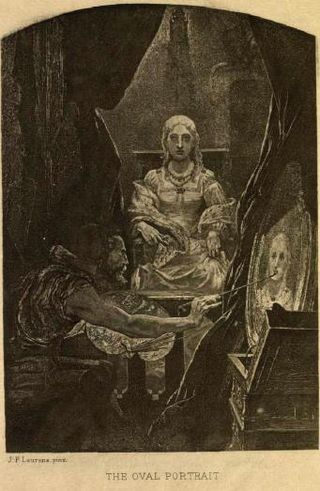
"The Oval Portrait" is a horror short story by American writer Edgar Allan Poe, involving the disturbing circumstances of a portrait in a château. It is one of his shortest stories, filling only two pages in its initial publication in 1842.

"Al Aaraaf" is an early poem by American writer Edgar Allan Poe, first published in 1829. It tells of the afterlife in a place called Al Aaraaf, inspired by A'raf as described in the Quran. At 422 lines, it is Poe's longest poem.
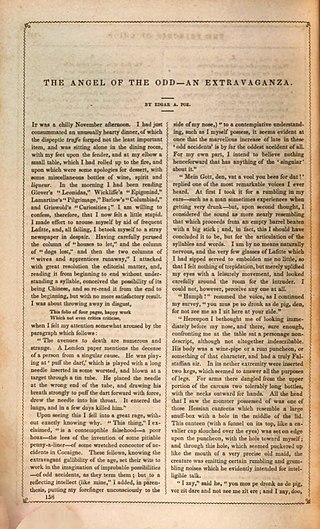
"The Angel of the Odd" is a satirical short story by Edgar Allan Poe, first published in 1844 in The Columbian Lady's and Gentleman's Magazine.
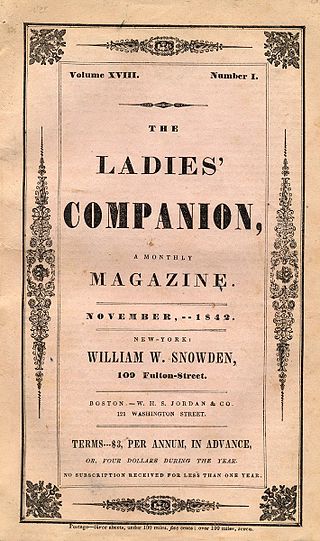
"The Mystery of Marie Rogêt", often subtitled A Sequel to "The Murders in the Rue Morgue", is a short story by American writer Edgar Allan Poe written in 1842. This is the first murder mystery based on the details of a real crime. It first appeared in Snowden's Ladies' Companion in three installments, November and December 1842 and February 1843. Poe referred to it as one of his "tales of ratiocination".

The Edgar Allan Poe National Historic Site is a preserved home once rented by American author Edgar Allan Poe, located at 532 N. 7th Street, in the Spring Garden neighborhood of Philadelphia, Pennsylvania. Though Poe lived in many houses over several years in Philadelphia, it is the only one which still survives. It was designated a National Historic Landmark in 1962.
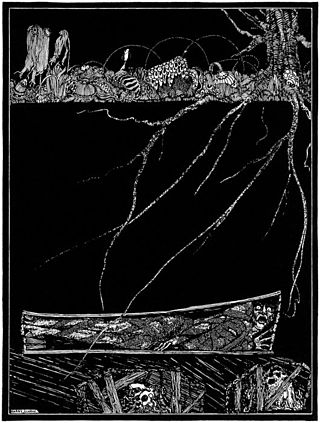
"The Premature Burial" is a horror short story by American writer Edgar Allan Poe, published in 1844 in The Philadelphia Dollar Newspaper. Its main character expresses concern about being buried alive. This fear was common in this period and Poe was taking advantage of the public interest. The story has been adapted to a film.

"Ligeia" is an early short story by American writer Edgar Allan Poe, first published in 1838. The story follows an unnamed narrator and his wife Ligeia, a beautiful and intelligent raven-haired woman. She falls ill, composes "The Conqueror Worm", and quotes lines attributed to Joseph Glanvill shortly before dying.
"Metzengerstein: A Tale in Imitation of the German" is a short story by American writer and poet Edgar Allan Poe, his first to see print. It was first published in the pages of Philadelphia's Saturday Courier magazine, in 1832. The story follows the young Frederick, the last of the Metzengerstein family, who carries on a long-standing feud with the Berlifitzing family. Suspected of causing a fire that kills the Berlifitzing family patriarch, Frederick becomes intrigued with a previously unnoticed and untamed horse. Metzengerstein is punished for his cruelty when his own home catches fire and the horse carries him into the flame. Part of a Latin hexameter by Martin Luther serves as the story's epigraph: Pestis eram vivus—moriens tua mors ero.

"Eleonora" is a short story by American writer Edgar Allan Poe, first published in 1842 in Philadelphia in the literary annual The Gift. It is often regarded as somewhat autobiographical and has a relatively "happy" ending.
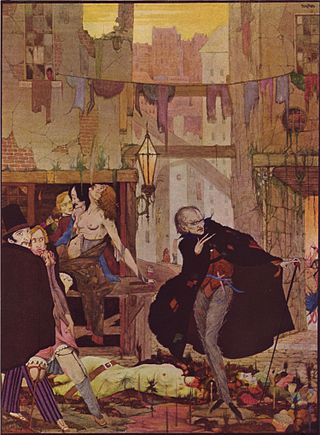
"The Man of the Crowd" is a short story by American writer Edgar Allan Poe about a nameless narrator following a man through a crowded London. It was first published in 1840.

The Conchologist's First Book is an illustrated textbook on conchology issued in 1839, 1840, and 1845. The book was originally printed under Edgar Allan Poe's name. The text was based on Manual of Conchology by Thomas Wyatt, an English author and lecturer.

"Hop-Frog" is a short story by American writer Edgar Allan Poe, first published in 1849. The title character, a person with dwarfism taken from his homeland, becomes the jester of a king particularly fond of practical jokes. Taking revenge on the king and his cabinet for the king's striking of his friend and fellow dwarf Trippetta, he dresses the king and his cabinet as orangutans for a masquerade. In front of the king's guests, Hop-Frog murders them all by setting their costumes on fire before escaping with Trippetta.

"Eulalie", or "Eulalie — A Song", is a poem by Edgar Allan Poe, first published in the July 1845 issue of The American Review and reprinted shortly thereafter in the August 9, 1845 issue of the Broadway Journal.
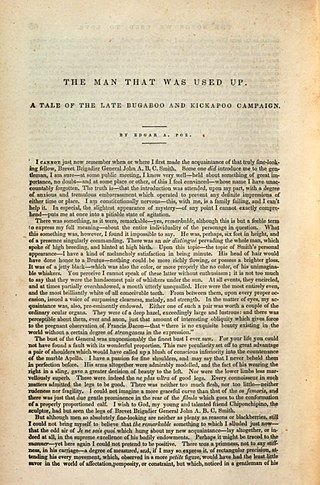
"The Man That Was Used Up", sometimes subtitled "A Tale of the Late Bugaboo and Kickapoo Campaign", is a short story and satire by Edgar Allan Poe. It was first published in August 1839 in Burton's Gentleman's Magazine.

"Never Bet the Devil Your Head: A Moral Tale" is a short story by American author Edgar Allan Poe, first published in 1841. The satirical tale pokes fun at the notion that all literature should have a moral and spoofs transcendentalism.
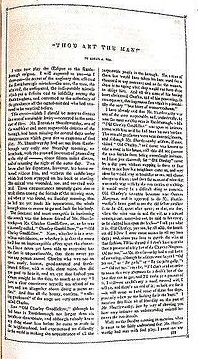
"Thou Art the Man", originally titled "Thou Art the Man!", is a short story by Edgar Allan Poe, first published in 1844. It is an early experiment in detective fiction, like Poe's "The Murders in the Rue Morgue", though it is generally considered an inferior story.
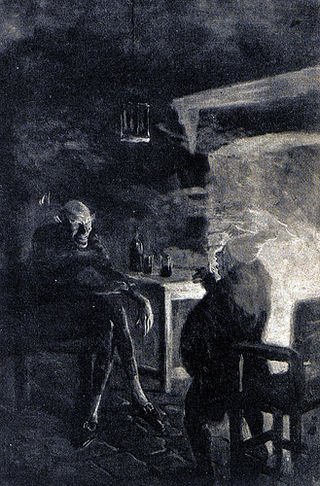
"Bon-Bon" is a comedic short story by Edgar Allan Poe, first published in December 1832 in the Philadelphia Saturday Courier. Originally called "The Bargain Lost", it follows Pierre Bon-Bon, who believes himself a profound philosopher, and his encounter with the Devil. The story's humor is based on the verbal interchange between the two, which satirizes classical philosophers such as Plato and Aristotle. The Devil reveals that he has eaten the souls of many of these philosophers.
